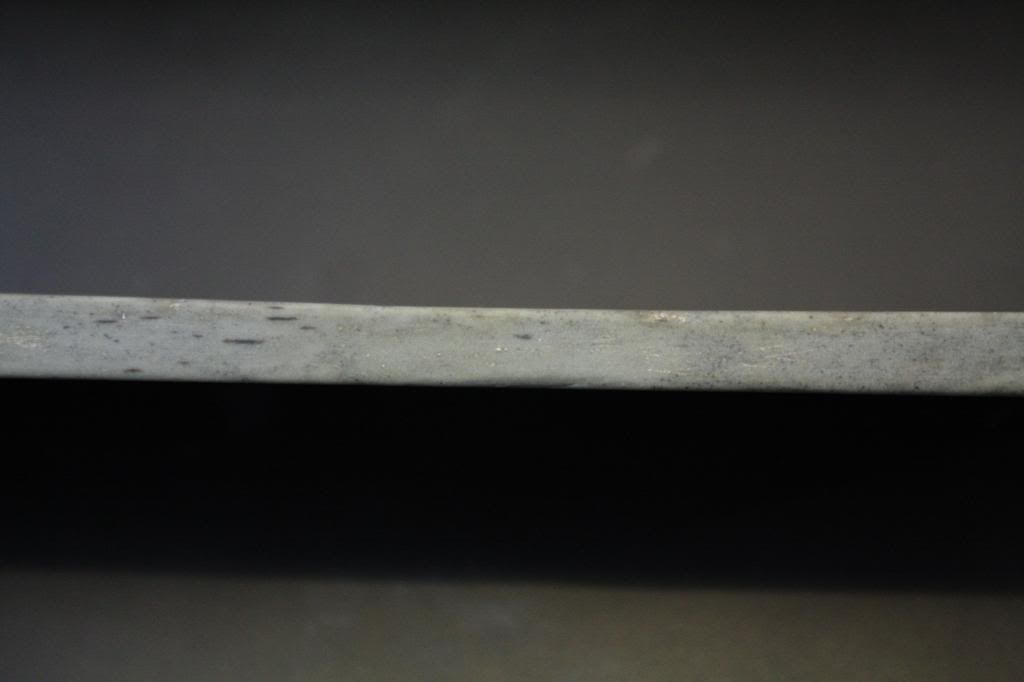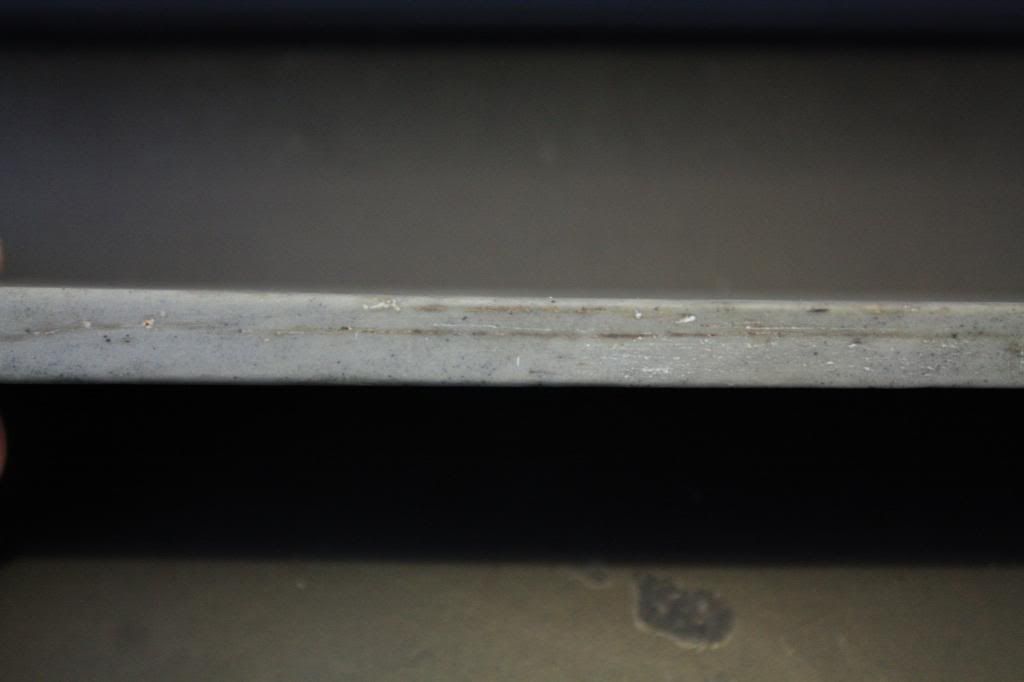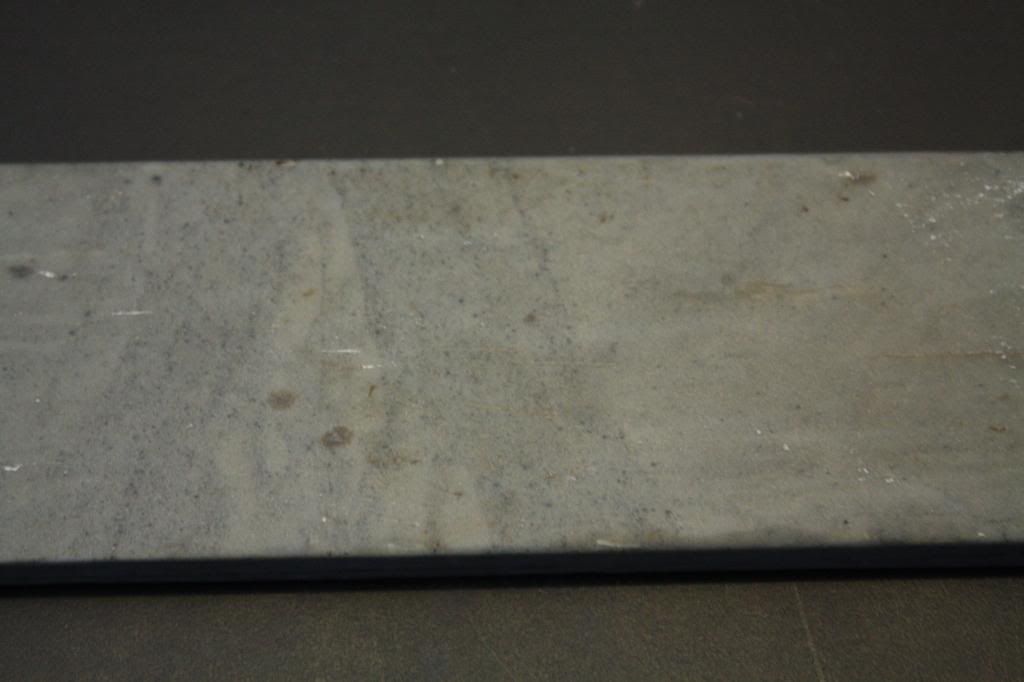Results 21 to 27 of 27
-
03-23-2013, 02:32 PM #21

On a second attempt in the oven I finally got it out and scrubbed as much plaster/oil off of the sides and bottom as I could get. Since this is so thin (1/4" at the thinnest point) should I just flatten the bottom because it's not as dished out as the top part was?
A couple dry side shots:


and the bottom look just the same as the top:

-
03-25-2013, 01:36 AM #22

I lapped it up to 600 grit sandpaper. The 220 and 320 grits lasted for awhile and did well to flatten the stone, but the 400 and 600 grit seemed to fall apart after a short time on the stone.
I transitioned a razor from a norton 8k to this stone using water. No slurry was created with honing. I even dried the "used" water off the hone and razor with a paper towel and found no visible steel. I will shave test tomorrow but it did pop arm hairs just as efficiently as my 8k can.
-
03-27-2013, 09:50 PM #23Junior Member

- Join Date
- Jan 2013
- Location
- Surrey, England
- Posts
- 28
Thanked: 3
How did the stone perform for you?
-
03-27-2013, 11:47 PM #24

Since this is both my first natural and what I think is higher than my 8k Norton, I need more time to experiment with it. The first attempt at a test was to follow the 8k with this stone using water. I did about 40 x-pattern strokes and observed the bevel with an unassisted eye (I really need a loupe). I couldn't notice any chipping and it seemed to be more polished than the 8k edge. I then skipped the stropping step and went straight to the shave. The razor is a full hollow 6/8 henckels, I had a day and a half of growth, and while it shaved my sideburns, cheeks, jaw, and neck satisfactorily for a first pass, my chin and mustache area seemed a little more difficult than usual (which resulted in some razor burn on my chin). I cannot comment on the smoothness as I finished the shave with a DE.
Now I have a few options:
1. Put the razor back to stone for more passes on water just in case it is a slow cutter and shave again.
2. Do step one but add stropping before the shave.
3. Try the stone with oil.
-
03-28-2013, 07:57 AM #25Junior Member

- Join Date
- Jan 2013
- Location
- Surrey, England
- Posts
- 28
Thanked: 3
There is a chance that your stone is not like mine although they do look very similar indeed. Other stones from this region of Wales (Llyn idwal)are very hard, fine and can apparently make good finishers (I've not had one). My stone is not a good finishing stone and I suspect that yours is not good for this purpose. IMHO yours would best be used between your 4k and 8k or as an alternative to the 4k. You would probably only have to do some very light work on the 8K after using it. I really like using mine as a mid stone and I find I can get a really good pre finished edge on it and I just love the feel of the stone.
-
03-28-2013, 10:18 AM #26Senior Member



- Join Date
- Apr 2008
- Location
- Essex, UK
- Posts
- 3,816
Thanked: 3164
I have used very many examples of that kind of LI (sometimes called 'Grecian Oilstone' or 'Welsh Oilstone' in older trade catalogues) and have yet to find one that is below an equivalent grit rating of around 9k. Most are 10k and upwards, good hard ones around 14k. They are not that fast (not too painfully slow) but you do have to perform quite a few laps to get the best out of them. The bevel on the razor before going on to this stone should be spot on, as metal removal is minimal, but if the edge is as said, it produces first rate results, if a little on the 'crisp' side.
Llyn Idwal hones vary a lot - highly figurative with swathes and bands of spots like the Grecian type, to darker green of an unremarkable appearance and all ports between. The hardness range varies too - some are softer than Charnley Forest hones, some are harder. The hard, dark ones are usually higher in equivalent grit rating and give a finer edge. They are also much harder to lap flat than the lighter ones - usually!
The tendency to 'crispness' or 'harshness' can be alleviated by using the stone as it was originally intended to be used - the clue is in the old names for it - with oil. Oil, however, makes it a bit of a messy process and one of the water-based honing fluids that increase the viscosity of water to a small extent, like HoneRite, give admirable results.
As with other stones of this type (novaculite) the fineness of the final lapping greatly influences the performance - a coarser lapping job will make honing a little faster, but coarser, and very fine lapping will make honing slightly slower, but give slightly finer results.
Some people think this type of hone can actually diminish the edge of a razor going on to it, but that is usually attributable to poor bevel creation, poor lapping, using gritty slurry or a combination of all three. It takes time to learn how to use these stones - especially given their slowness - and get the best from them. A good loupe is really a pre-requisite - the bevel should be inspected before taking the razor to an LI (or any final finishing hone) and taken back to previous hones if found wanting.
Regards,
Neil
-
The Following User Says Thank You to Neil Miller For This Useful Post:
TwistedOak (03-28-2013)
-
03-28-2013, 10:24 AM #27Junior Member

- Join Date
- Jan 2013
- Location
- Surrey, England
- Posts
- 28
Thanked: 3
Great post Neil. You are teaching me a lot. My Grecian is soft, fast and not that fine. But it's the only one I've ever used and I dont like using it with oil, so that may be an influencing factor.


 8Likes
8Likes LinkBack URL
LinkBack URL About LinkBacks
About LinkBacks







 Reply With Quote
Reply With Quote